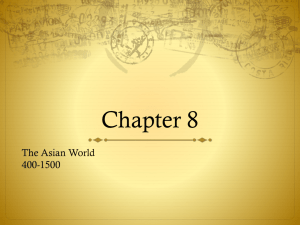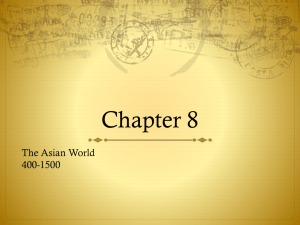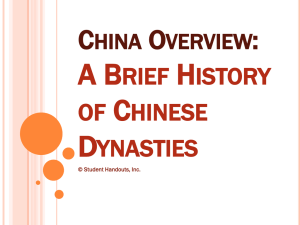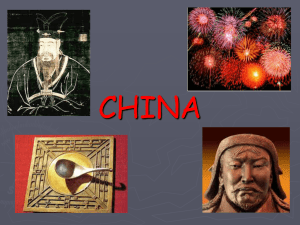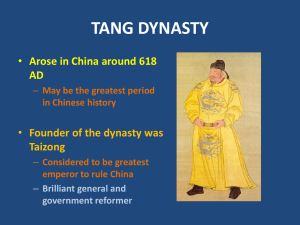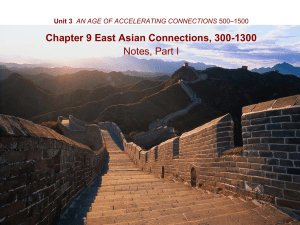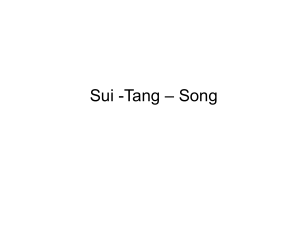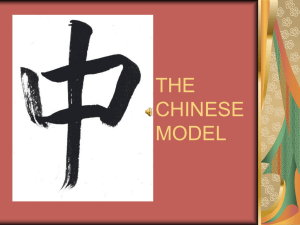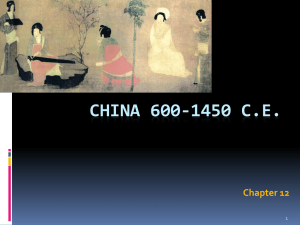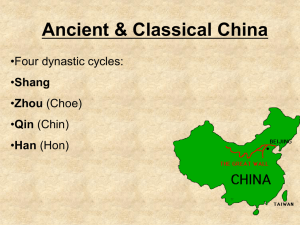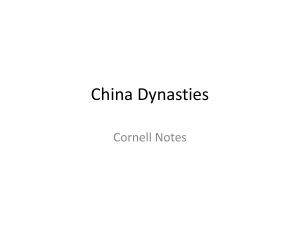Asian Empires - wilsonworldhistory1213
advertisement
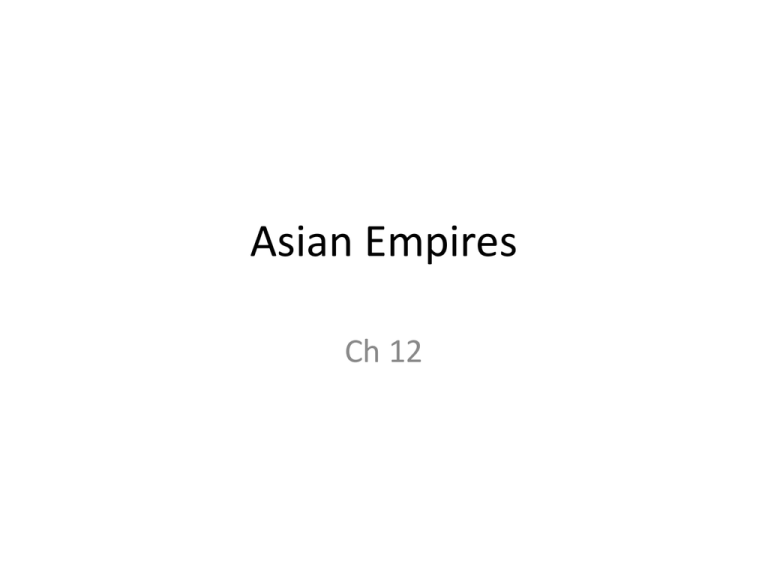
Asian Empires Ch 12 Empires of China Section 1 Tang Dynasty • Who: Li Yuan; Li Shimin; Chinese & Tang family • What: a dynasty that was formed in China after a revolt that brought back China’s glory by reunifying it • Where: China • When: 618-907 • Why: this dynasty restored China’s earlier glory; carried the empire to new heights, conquered some of central Asia = expanded China; rebuilt bureaucracy & enlarged the civil service system; eventually lost territ. & there was corruption & famine = downfall Tang Taizong • Who: founder of the Tang dynasty; ruler of China (Li Shimin) • What: a brilliant general, government reformer, Historian • Where: China • When: 618• Why: he became China’s most admired emperor; revolted from his father to est. new dynasty; Tang rulers carried the empire & built China to new heights; conquered territories= expanded china = China had more power; founded Tang dynasty = imp dynasty in China Tributary States • Who: Chinese emperors & people • What: independent state that has to acknowledge the supremacy of another state & pay tribute to its’ ruler • Where: Asia • When: 220-618 • Why: Tibet, Korea, & Vietnam were self-ruling & governing however they had to acknowledge Chinese supremacy in the region of Asia; they had to send regular tribute ($$) to the Tang Empire; kept China in power & # 1 Land Reform • Who: Chinese Tang Emperors • What: broke up large agricultural holdings & redistributed land to the peasants; a policy that the Tang dynasty had • Where: China • When: 618 • Why: this policy strengthened the central government by weakening the power of large land owners= increased government revenues; Tang emperors more powerful; peasants now could own land & would be able to pay taxes Tang (workbook) • Tang Taizong founded the dynasty by overthrowing his father & starting new • Land Reform= increased gov’t revenues, made central power more powerful • Rebuilt the bureaucracy • Developed a flexible new law code • Enlarged the civil service system • Set up schools to prepare males for civil service exams = could get govt jobs • Conquered centralAsia = more land = more power Tang Dynasty (workbook) • Tang Taizong founds the dynasty • Reinstated a powerful bureaucracy & centralized government • Created a new law code = helped to strengthen the govt • Instituted the land reform system=took power away from nobles & gave to emperor • Set up schools to educate the men for Civil Service exams = become Civil service workers= merit based for the 1st time • Conquered Central Asia = expanded land = more pwer • Decline due to corruption, famine, & losing territ Song Dynasty • Who: Zhao Kuangyin, scholarly general, Song Chinese • What: a dynasty that ruled China for 319 years after the Tang but controlled less territ • Where: China • When: 960-1200s • Why: they faced constant threat of invaders from the North; during the Song period- great time of achievement= Chinese econ expanded b.c. improved farming methods & open border policy; the Grand Canal reached its peak during this time; foreign trade flourished= govt issued paper money (didn’t exist anywhere else!) ; well ordered society- gentry & peasants Gentry • • • • • Who: scholars & officials What: a wealthy landowning class of people Where: China When: 960-1200s Why: they could afford to spend years studying the Confucian classics in order to pass the civil service exams & get govt positions; when not in govt positions they served in provinces as allies to the emperors Dowry • Who: Chinese brides • What: the payment that a woman brings into a marriage to give to husband & she can never remarry • Where: China • When: 500-1650 • Why: famlies valued boys more than girls; when girls married she brought this dowry as a gift to the husband’s family- she now became part of his family & left to live with them- this dowry was to give her hubby’s fam $$ for taking her in Pagoda • Who: Chinese • What: a multi-tiered structure with eaves that curve up at the bottom that evolved from India’s Stupa • WherE: China • When: 500-1650 • Why: many important Chinese nobles used this as their house; Buddhist themes dominated Chinese architecture & created a large Indian/Hindu influence throughout China Section 2 Genghis Khan • Who: Mongol chieftan • What: united warring tribes as one under his control and then conquered Asia; brilliant Mongol leader, “Universal Ruler”; greatest conqueror in history • Where: Mongolia, invades Asia & Europe • When: 1162-1227 • Why: under his leadership he united the Mongols & they conquered a vast empire from Pacific Ocean all the way to E. Europe; had highly trained armies; imposed strict military discipline & demanded loyalty; ruled his lands with toleration & justice; tried to conquer China but didn’t live to complete- his grandson started the Yuan dynasty in China Kublai Khan • Who: Genghis Khan’s grandson; founder of Yuan dynasty • What: finished invading China for the Mongols & started the Yuan dynasty (the foreign run dynasty) in China • Where: from Mongolia, took over Northern China • When: 1279 • Why: he ruled all of China & Korea & Tibet; he tried to prevent the Mongols from being absorbed into Chinese civilization; he decreed that only Mongols could serve in the Chinese military & hold govt positions- keeping Mongols on the top of society Yuan Dynasty • • • • • Who: Khublai Khan & the Mongols What: a foreign run, Mongol dynasty in China Where: China When: 1227-1368 Why: this dynasty was foreign-run by the Mongols in China= they wanted to stay Mongol, not become Chinese= strict social structure- Mongols are at the top (govt, milit jobs), other foreignersmiddle & Chinese at the bottom = Chinese don’t like them; Khublai rebuilt & extended the Grand Canal to reach his capital; Blended Mongol & Chinese cultures, customs, & traditions Marco Polo • Who: Italian merchant • What: a traveler & merchant from Venice, Italy who traveled to China during the Yuan dynasty • Where: from Italy, went to China • When: 1254-1324 • Why: he visited China during the Yuan dynasty; he got there in 1271; he traveled across Persia & Asia- spent 17 years in China learning about it; when he returned to Italy he wrote about his travels= educated Europe about Asia= Europeans wanted to get there for the goods= Exploration Ming Dynasty • Who: Zhu Yuanzhang, Zheng He • What: new dynasty of China that sought to reassert Chinese greatness after years of foreign rule • Where: China • When: 1368-1435 • Why: (I will have the why up tomorrow) Zheng He • Who: Chinese explorer, Admiral & diplomat • What: he commanded 7 exploration expeditions for the Chinese Ming dynasty • Where: China • When: 1405-1433 • Why: he wanted to explore to promote trade & collect tribute from lesser powers across the western seas; he explored the seas of SE Asia, India, Red Sea, & E. Africa= Chinese settled in these regions; exotic animals returned to China & these voyages showed local rulers the power & strength of the Chinese empire.
